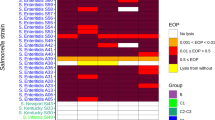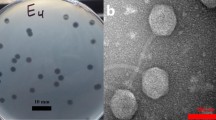Abstract
In this study, we sought to isolate Salmonella Enteritidis-specific lytic bacteriophages (phages), and we found a lytic phage that could lyse not only S. Enteritidis but also other Gramnegative foodborne pathogens. This lytic phage, SS3e, could lyse almost all tested Salmonella enterica serovars as well as other enteric pathogenic bacteria including Escherichia coli, Shigella sonnei, Enterobacter cloacae, and Serratia marcescens. This SS3e phage has an icosahedral head and a long tail, indicating belong to the Siphoviridae. The genome was 40,793 base pairs, containing 58 theoretically determined open reading frames (ORFs). Among the 58 ORFs, ORF49, and ORF25 showed high sequence similarity with tail spike protein and lysozyme-like protein of Salmonella phage SE2, respectively, which are critical proteins recognizing and lysing host bacteria. Unlike SE2 phage whose host restricted to Salmonella enterica serovars Enteritidis and Gallinarum, SS3e showed broader host specificity against Gram-negative enteric bacteria; thus, it could be a promising candidate for the phage utilization against various Gram-negative bacterial infection including foodborne pathogens.
Similar content being viewed by others
References
Andres, D., Hanke, C., Baxa, U., Seul, A., Barbirz, S., and Seckler, R. 2010. Tailspike interactions with lipopolysaccharide effect DNA ejection from phage P22 particles in vitro. J. Biol. Chem. 285, 36768–36775.
Baxa, U., Cooper, A., Weintraub, A., Pfeil, W., and Seckler, R. 2001. Enthalpic barriers to the hydrophobic binding of oligosaccharides to phage P22 tailspike protein. Biochemistry 40, 5144–5150.
Capra, M.L., Quiberoni, A.L., Ackermann, H.W., Moineau, S., and Reinheimer, J.A. 2006. Characterization of a new virulent phage (MLC-A) of Lactobacillus paracasei. J. Dairy Sci. 89, 2414–2423.
Carbonell, X. and Villaverde, A. 1998. Insertional mutagenesis in the tailspike protein of bacteriophage P22. Biochem. Biophys. Res. Commun. 244, 428–433.
Choi, I.Y., Lee, J.H., Kim, H.J., and Park, M.K. 2017. Isolation and characterization of a novel broad-host-range bacteriophage infecting Salmonella enterica subsp. enterica for biocontrol and rapid detection. J. Microbiol. Biotechnol. 27, 2151–2155.
Cisek, A.A., Dabrowska, I., Gregorczyk, K.P., and Wyzewski, Z. 2017. Phage therapy in bacterial infections treatment: One hundred years after the discovery of bacteriophages. Curr. Microbiol. 74, 277–283.
Crowlesmith, I., Schindler, M., and Osborn, M.J. 1978. Bacteriophage P22 is not a likely probe for zones of adhesion between the inner and outer membranes of Salmonella Typhimurium. J. Bacteriol. 135, 259–269.
Darling, A.C., Mau, B., Blattner, F.R., and Perna, N.T. 2004. Mauve: Multiple alignment of conserved genomic sequence with rearrangements. Genome Res. 14, 1394–1403.
De Lappe, N., Doran, G., O’Connor, J., O’Hare, C., and Cormican, M. 2009. Characterization of bacteriophages used in the Salmonella enterica serovar Enteritidis phage-typing scheme. J. Med. Microbiol. 58, 86–93.
Dobbins, A.T., George, M.Jr., Basham, D.A., Ford, M.E., Houtz, J.M., Pedulla, M.L., Lawrence, J.G., Hatfull, G.F., and Hendrix, R.W. 2004. Complete genomic sequence of the virulent Salmonella bacteriophage SP6. J. Bacteriol. 186, 1933–1944.
Eriksson, U., Svenson, S.B., Lonngren, J., and Lindberg, A.A. 1979. Salmonella phage glycanases: Substrate specificity of the phage P22 endo-rhamnosidase. J. Gen. Virol. 43, 503–511.
Gorski, A., Miedzybrodzki, R., Borysowski, J., Weber-Dabrowska, B., Lobocka, M., Fortuna, W., Letkiewicz, S., Zimecki, M., and Filby, G. 2009. Bacteriophage therapy for the treatment of infections. Curr. Opin. Investig. Drugs 10, 766–774.
Hauser, A.R., Mecsas, J., and Moir, D.T. 2016. Beyond antibiotics: New therapeutic approaches for bacterial infections. Clin. Infect. Dis. 63, 89–95.
Jamalludeen, N., She, Y.M., Lingohr, E.J., and Griffiths, M. 2009. Isolation and characterization of virulent bacteriophages against Escherichia coli serogroups O1, O2, and O78. Poult. Sci. 88, 1694–1702.
Khalifa, L., Gelman, D., Shlezinger, M., Dessal, A.L., Coppenhagen-Glazer, S., Beyth, N., and Hazan, R. 2018. Defeating antibioticand phage-resistant Enterococcus faecalis using a phage cocktail in vitro and in a clot model. Front. Microbiol. 9, 326.
Kim, S. 2010. Salmonella serovars from foodborne and waterborne diseases in Korea, 1998–2007: total isolates decreasing versus rare serovars emerging. J. Korean Med. Sci. 25, 1693–1699.
Kim, S.H., Kim, S., Chun, S.G., Park, M.S., Park, J.H., and Lee, B.K. 2008. Phage types and pulsed-field gel electrophoresis patterns of Salmonella enterica serovar Enteritidis isolated from humans and chickens. J. Microbiol. 46, 209–213.
Kim, S.H., Park, J.H., Lee, B.K., Kwon, H.J., Shin, J.H., Kim, J., and Kim, S. 2012b. Complete genome sequence of Salmonella bacteriophage SS3e. J. Virol. 86, 10253–10254.
Kim, S., Rahman, M., Seol, S.Y., Yoon, S.S., and Kim, J. 2012a. Pseudomonas aeruginosa bacteriophage PA1O requires type IV pili for infection and shows broad bactericidal and biofilm removal activities. Appl. Environ. Microbiol. 78, 6380–6385.
Kumar, S., Rizvi, M., and Berry, N. 2008. Rising prevalence of enteric fever due to multidrug-resistant Salmonella: An epidemiological study. J. Med. Microbiol. 57, 1247–1250.
Kwiatkowski, B., Boschek, B., Thiele, H., and Stirm, S. 1982. Endo- N-acetylneuraminidase associated with bacteriophage particles. J. Virol. 43, 697–704.
Ledet Muller, L., Hjertqvist, M., Payne, L., Pettersson, H., Olsson, A., Plym Forshell, L., and Andersson, Y. 2007. Cluster of Salmonella Enteritidis in Sweden 2005–2006 - suspected source: Almonds. Euro Surveill. 12, E9–10.
Lu, T.K. and Koeris, M.S. 2011. The next generation of bacteriophage therapy. Curr. Opin. Microbiol. 14, 524–531.
Marcus, R., Varma, J.K., Medus, C., Boothe, E.J., Anderson, B.J., Crume, T., Fullerton, K.E., Moore, M.R., White, P.L., Lyszkowicz, E., et al. 2007. Re-assessment of risk factors for sporadic Salmonella serotype Enteritidis infections: a case-control study in five FoodNet Sites, 2002–2003. Epidemiol. Infect. 135, 84–92.
Matsuzaki, S., Rashel, M., Uchiyama, J., Sakurai, S., Ujihara, T., Kuroda, M., Ikeuchi, M., Tani, T., Fujieda, M., Wakiguchi, H., et al. 2005. Bacteriophage therapy: A revitalized therapy against bacterial infectious diseases. J. Infect. Chemother. 11, 211–219.
McNerney, R., Wilson, S.M., Sidhu, A.M., Harley, V.S., al Suwaidi, Z., Nye, P.M., Parish, T., and Stoker, N.G. 1998. Inactivation of mycobacteriophage D29 using ferrous ammonium sulphate as a tool for the detection of viable Mycobacterium smegmatis and M. tuberculosis. Res. Microbiol. 149, 487–495.
Mmolawa, P.T., Schmieger, H., Tucker, C.P., and Heuzenroeder, M.W. 2003. Genomic structure of the Salmonella enterica serovar Typhimurium DT 64 bacteriophage ST64T: Evidence for modular genetic architecture. J. Bacteriol. 185, 3473–3475.
Nhung, N.T., Van, N.T.B., Cuong, N.V., Duong, T.T.Q., Nhat, T.T., Hang, T.T.T., Nhi, N.T.H., Kiet, B.T., Hien, V.B., Ngoc, P.T., et al. 2018. Antimicrobial residues and resistance against critically important antimicrobials in non-typhoidal Salmonella from meat sold at wet markets and supermarkets in Vietnam. Int. J. Food Microbiol. 266, 301–309.
Peters, T.M., Berghold, C., Brown, D., Coia, J., Dionisi, A.M., Echeita, A., Fisher, I.S., Gatto, A.J., Gill, N., Green, J., et al. 2007. Relationship of pulsed-field profiles with key phage types of Salmonella enterica serotype Enteritidis in Europe: results of an international multi-centre study. Epidemiol. Infect. 135, 1274–1281.
Pires, D.P., Melo, L., Vilas Boas, D., Sillankorva, S., and Azeredo, J. 2017. Phage therapy as an alternative or complementary strategy to prevent and control biofilm-related infections. Curr. Opin. Microbiol. 39, 48–56.
Rahman, M., Kim, S., Kim, S.M., Seol, S.Y., and Kim, J. 2011. Characterization of induced Staphylococcus aureus bacteriophage SAP- 26 and its anti-biofilm activity with rifampicin. Biofouling 27, 1087–1093.
Scholl, D., Rogers, S., Adhya, S., and Merril, C.R. 2001. Bacteriophage K1-5 encodes two different tail fiber proteins, allowing it to infect and replicate on both K1 and K5 strains of Escherichia coli. J. Virol. 75, 2509–2515.
Sillankorva, S., Oliveira, D., Moura, A., Henriques, M., Faustino, A., Nicolau, A., and Azeredo, J. 2011. Efficacy of a broad host range lytic bacteriophage against E. coli adhered to urothelium. Curr. Microbiol. 62, 1128–1132.
Steinbacher, S., Seckler, R., Miller, S., Steipe, B., Huber, R., and Reinemer, P. 1994. Crystal structure of P22 tailspike protein: Interdigitated subunits in a thermostable trimer. Science 265, 383–386.
Tanaka, K., Nishimori, K., Makino, S., Nishimori, T., Kanno, T., Ishihara, R., Sameshima, T., Akiba, M., Nakazawa, M., Yokomizo, Y., et al. 2004. Molecular characterization of a prophage of Salmonella enterica serotype Typhimurium DT104. J. Clin. Microbiol. 42, 1807–1812.
Tiwari, B.R., Kim, S., and Kim, J. 2012. Complete genomic sequence of Salmonella enterica serovar Enteritidis phage SE2. J. Virol. 86, 7712.
Tiwari, B.R., Kim, S., and Kim, J. 2013. A virulent Salmonella enterica serovar Enteritidis phage SE2 with a strong bacteriolytic activity of planktonic and biofilmed cells. J. Bacteriol. Virol. 43, 186–194.
Vander Byl, C. and Kropinski, A.M. 2000. Sequence of the genome of Salmonella bacteriophage P22. J. Bacteriol. 182, 6472–6481.
Waseh, S., Hanifi-Moghaddam, P., Coleman, R., Masotti, M., Ryan, S., Foss, M., MacKenzie, R., Henry, M., Szymanski, C.M., and Tanha, J. 2010. Orally administered P22 phage tailspike protein reduces Salmonella colonization in chickens: prospects of a novel therapy against bacterial infections. PLoS One 5, e13904.
Ye, J., Kostrzynska, M., Dunfield, K., and Warriner, K. 2009. Evaluation of a biocontrol preparation consisting of Enterobacter asburiae JX1 and a lytic bacteriophage cocktail to suppress the growth of Salmonella Javiana associated with tomatoes. J. Food Prot. 72, 2284–2292.
Yu, L., Wang, S., Guo, Z.M., Liu, H.T., Sun, D.G., Yan, G.M., Hu, D.L., Du, C.T., Feng, X., Han, W.Y., et al. 2018. A guard-killer phage cocktail effectively lyses the host and inhibits the development of phage-resistant strains of Escherichia coli. Appl. Microbiol. Biotechnol. 102, 971–983.
Author information
Authors and Affiliations
Corresponding author
Additional information
Supplemental material for this article may be found at http://www.springerlink.com/content/120956.
Electronic supplementary material
Rights and permissions
About this article
Cite this article
Kim, S., Kim, SH., Rahman, M. et al. Characterization of a Salmonella Enteritidis bacteriophage showing broad lytic activity against Gram-negative enteric bacteria. J Microbiol. 56, 917–925 (2018). https://doi.org/10.1007/s12275-018-8310-1
Received:
Revised:
Accepted:
Published:
Issue Date:
DOI: https://doi.org/10.1007/s12275-018-8310-1




